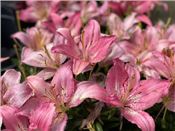Gardening Page
Consider The Lilies: A Symbol Of Springtime Beauty
HEATHER KIRK-BALLARD
BATON ROUGE, LOUISIANA
Spring brings many beautiful flowers, but none more beautiful than the lily. Readily found this time of year and often used for celebrations and decorating in the spring, lilies are important to many cultures and mentioned often in literature. Just one look at these showy flowers and there is no denying why they are so loved.
Lilies (Lilium spp.) are hardy, herbaceous, flowering perennials grown from bulbs. Those in the Lilium genus are true lilies unlike other commonly named plants such as daylilies and canna lilies that grow from tubers. Lilies have very large, showy flowers, and some have a strong fragrance. Many species are native to the Northern Hemisphere and grow well in temperate to subtropical climates in USDA hardiness zones 4 to 9.
There are several lily options for both cut flower production and landscape use. Each has unique colors and bloom times. You can start your own lilies from bulbs in early spring or in fall. Container-grown plants can be planted any time of year. Many varieties bloom in springtime, and some will bloom in mid-to-late summer.
Asiatic hybrids are bred from several different species of lilies.
They have three to six flowers per stem, and the petals are often spotted. Asiatic lilies do not have a fragrance, and their flowers tend to be smaller. Asiatic lilies make wonderful, long-lasting cut flowers.
Oriental lilies have some of the largest, most fragrant flowers and broader leaves. The anthers of Oriental lilies produce dark, heavy pollen that can stain clothes. They come in shades of pink, purple, white and yellow. If used as a cut flower, pull off the anthers as the bloom opens to keep the pollen from staining fabrics.
Trumpet lilies are hybrids that produce prolific, trumpet-shaped, colorful flowers that are long-lasting and highly fragrant, making them excellent selections for cut flowers. Some trumpet lily varieties have a dozen or more buds on individual stems. Trumpet lilies produce flowers in colors of orange, pink, white and yellow. African Queen is one of the most commonly found varieties.
Orienpet lilies are a cross between Oriental hybrids and trumpet lilies. Their heavily fragranced blooms have a shortened trumpet shape and come in shades of pink, yellow, red, orange and white. The plants reach 2 to 3 feet in height, making them a striking cut flower choice.
LA hybrid lilies are a cross between “Easter-type” lilies (Longiflorium) and Asiatic lilies. LA isn’t a reference to Louisiana here; rather, the L stands for Longiflorium and the A for Asiatic. LA hybrids come in a wide range of colors with large blooms and little fragrance. They make great additions to the garden and are excellent cut flowers. They are prolific bloomers.
What we know as Easter lilies are sold almost exclusively as a holiday plant. The familiar white, trumpet-shaped, outward-facing flower reaches 1 to 3 feet tall. There are several different cultivars of this lily with the classic Easter lily appearance. These lilies are forced to bloom out of season, just in time for Easter. These types are cold hardy and can be planted into your garden after they’ve completed their bloom. They will bloom year after year in the landscape.
The Canada lily, a native of North America, typically displays orange and yellow flowers. They are more shade tolerant than other types of lilies and grow well in wooded areas. This is a multiflowered stem lily with smaller flowers.
Lilies are easy to care for once established. They grow best in well- drained, fertile soil. Some may require staking to prevent them from falling over. If you’re growing lilies in pots, let the soil dry out in between watering to prevent bulbs from rotting.
Remove faded blooms but do not remove leaves. Let all types of lilies die back naturally, and then remove dead leaves. Green leaves continue to photosynthesize throughout the growing season and put away energy reserves in their bulbs in preparation for winter. In the autumn, after stalks and leaves have turned brown, cut the lily plants down to the ground.
Bulbs will multiply and the plants will grow into large clumps with many stems, blooming year after year. They don’t mind being crowded but can benefit from dividing every three to five years. ∆
HEATHER KIRK-BALLARD: LSU AgCenter

There are many types of lilies available in many unique colors.
Photos by Heather Kirk-Ballard/LSU AgCenter

Lilies are highly used in spring. They are great cut flowers and grow well in the garden.

Although commonly called a lily, callas are not a true lily.